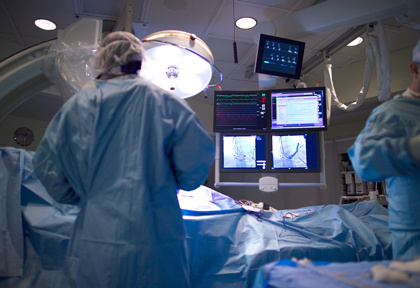 Contrast induced kidney injury incidence is in direct correlation to the administered contrast. The aim of this study was to assess the safety and efficacy of sinus aspiration immediately after PCI as a measure to reduce the volume of contrast arriving in the kidneys.
Contrast induced kidney injury incidence is in direct correlation to the administered contrast. The aim of this study was to assess the safety and efficacy of sinus aspiration immediately after PCI as a measure to reduce the volume of contrast arriving in the kidneys.
The study included 43 patients with diabetes and renal impairment (creatinine between 1.5 and 3 mg/dL) that were candidates for a coronary angiography.
Sinus aspiration was performed in 18 patients out of 43, and the rest served as control group. All patients received periprocedural standard care.
Aspiration was done directly from a trans-septal sheath via femoral or subclavian approach in 8 patients; other 10 patients were accessed through a balloon occlusion catheter placed through the sheath simultaneously during coronary angiography.
The estimated contrast volume aspirated was based on the reduction in hematocrit value of the aspirate (reduced by contrast) in relation to the patient’s baseline hematocrit. Fraction of aspirated contrast was calculated by dividing the estimated volume of aspirated contrast over the volume of injected contrast multiplied by 100.
Both the group receiving coronary sinus aspiration and the control group resulted similar as to clinical and lab characteristics, as well as administered contrast.
In the active group, aspirated contrast fraction was 39.35 ± 10.47%. Only one patient in the coronary sinus aspiration group, vs. 9 patients in the control group, presented contrast induced kidney injury (p=0.028).
Conclusion
Coronary sinus aspiration during coronary angiography can effectively remove up to a third of the administered contrast, reducing contrast kidney injury in selected patients.
Editorial Comment
This maneuver appears to be simple and logical; in fact, after reading Dr Diab’s work, most of us might have thought “how come we didn’t think of this before”.
This study does not report important complications, and contrast induced kidney injury reduction rate is quite significant; however, more definite conclusions call for a larger, more important study.
Original Title: Efficacy and Safety of Coronary Sinus Aspiration during Coronary Angiography to Attenuate the Risk of Contrast-Induced Acute Kidney Injury in Predisposed Patients.
Reference: Osama Ali Diab et al. Circ Cardiovasc Interv. 2017 Jan;10(1):e004348.
Subscribe to our weekly newsletter
Get the latest scientific articles on interventional cardiology
We are interested in your opinion. Please, leave your comments, thoughts, questions, etc., below. They will be most welcome.





